文章信息
- 卜世勋, 张福崇, 方笑, 李永仁. 2022.
- BU Shi-xun, ZHANG Fu-chong, FANG Xiao, LI Yong-ren. 2022.
- 河北抚宁海湾扇贝养殖区浮游植物与水质因子的相关研究
- Relationship between phytoplankton and water quality factors in the Argopecten irradians culture area of Funing Bay, Hebei
- 海洋科学, 46(10): 150-158
- Marine Sciences, 46(10): 150-158.
- http://dx.doi.org/10.11759/hykx20210926002
-
文章历史
- 收稿日期:2021-09-26
- 修回日期:2022-04-07
2. 河北省海洋与水产科学研究院, 河北 秦皇岛 066000
2. Hebei Ocean and Fisheries Science Research Institute, Qinhuangdao 066000, China
河北省秦皇岛海域位于渤海西部, 水质清肥, 沙砾底质, 是我国海湾扇贝Argopecten irradians的主要养殖区[1], 主要分布于离岸1.5~4海里的浅海。
海湾扇贝属软体动物门, 瓣鳃纲, 异柱目, 扇贝科, 海湾扇贝属, 中国科学院海洋研究所于1982年由北美洲引入国内养殖, 是我国的四大养殖贝类之一[2]。海湾扇贝对养殖水体依赖性高, 其生存与生长需要海水保持一定的动态平衡, 海水中任何指标的异常都会对海湾扇贝的健康养殖造成威胁[3]。海湾扇贝滤食海水中的单细胞藻类, 影响海水的透明度, 同时向水体中排泄营养盐, 为浮游植物的生长提供条件[4], 导致海域的营养盐、浮游植物具有独特的分布规律。
2009—2014年期间, 秦皇岛近海连续6年发生抑食金球藻褐潮, 导致海湾扇贝滞长甚至死亡, 损失巨大[5]。2010年, 褐潮发生规模最大面积达到了3 350 km2, 致使河北全省经济直接损失2亿元[6]。因此, 该海域浮游植物与水质因子受到广泛关注, 张建乐等[7]调查了2004年秦皇岛海域浮游植物构成, 发现硅藻种类数占浮游植物总种数的81.8%; 慕建东等[8]研究了2010年秦皇岛海域N/P、盐度、硝酸盐、硅酸盐、亚硝酸盐、水温等与浮游植物群落结构特征的关系; 也有研究表明氮盐是导致水体富营养化的主要因子[9]。本团队选取海湾扇贝养殖密集区(抚宁县离岸2.5海里浅海), 持续监测常规水质因子和浮游植物, 分析二者的相关性, 以期为海湾扇贝浅海养殖以及海域生态治理提供数据参考。
1 研究方法 1.1 试验材料2020年5月至11月, 每月由抚宁人造河口海湾扇贝养殖区(离岸2.5海里, 如图 1)采集表层海水样本。
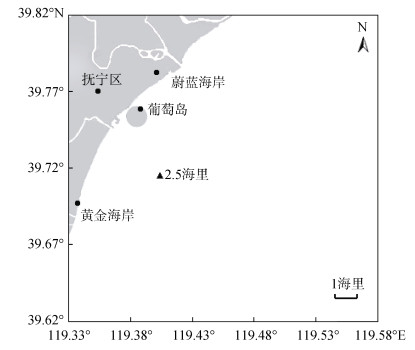 |
| 图 1 秦皇岛海湾扇贝养殖区调查站位图 Fig. 1 Location of survey stations in the Qinhuangdao Bay scallop breeding area |
现场测定温度、盐度, 海水样本带回实验室, 依照GB 17378.4—2007[10]、GB 17378.7—2007[11]、GB/T 12763.4—2007[12]测定COD、PO43–-P、SiO32–-Si、NH4+-N、NO2–-N、NO3–-N, 镜检样本的浮游植物种类、密度。
1.3 数据处理对浮游生物种类数、主要类群、优势种、数量、生态指数进行分析。相关指标计算公式如下[13]:
1) 物种优势度(Y)
| $ Y = \left( {\frac{{{n_i}}}{N}} \right) \times {f_i} , $ | (1) |
2) 生物多样性指数(H', Shannon - Weaver index)
| $ H' = - \sum\limits_{i = 1}^S {{P_i}} \times {\log _2}{P_i} , $ | (2) |
3) Pielou物种均匀度指数(J)
| $ J = \frac{{H'}}{{{{\log }_2}S}} , $ | (3) |
4) Margalef丰富度指数(D)
| $ D = \frac{{S - 1}}{{{{\log }_2}N}} , $ | (4) |
5) 浮游植物密度(N')采用浓缩计数法, 计算公式为:
| $ N' = \frac{{nV'}}{{VV''}} , $ | (5) |
其中, N′为浮游植物密度(cell/L); n为取样计数所得的细胞数目(个); V′为水样浓缩体积(mL); V为水样浓缩前体积(mL); V″为取样体积(mL); Pi为第i种的个体数量与样品总数量的比值; S为样品的总种类数; N为样品的总个体数; ni为第i种的个体数量; fi为第i种在各个站位分析样品中出现的频率; 优势度Y≥0.02时, 判定为优势种。
使用Canoco 5.0对浮游植物优势种与水质因子进行冗余分析及排序图绘制[14], 分析二者的关系。
2 结果与分析 2.1 浮游植物群落特征调查海域2020年鉴定浮游植物69种(表 1), 属硅藻门、绿藻门、蓝藻门、裸藻门、甲藻门、金藻门、隐藻门等7门。其中硅藻48种, 约占总浮游植物种数目的70%, 甲藻14种, 绿藻3种, 蓝、裸、金、隐藻各1种, 常见种类包括中肋骨条藻、舟形藻、菱形藻等, 甲藻门常见种有锥状斯克里普藻、微小原甲藻等。
| 种类 | 时间 | |||||||
| 5月 | 6月 | 7月 | 8月 | 9月 | 10月 | 11月 | ||
| 硅藻门 | 中肋骨条藻Skeletonema costatum | + | + | 0.28 | 0.14 | 0.19 | 0.25 | |
| 骨条藻Skeletonema sp. | 0.47 | 0.25 | + | |||||
| 条纹小环藻Cyclotella striata | + | + | + | |||||
| 大洋角管藻Cerataulina pelagica | 0.02 | + | ||||||
| 斯氏根管藻Rhizosolenia stolterfothii | + | 0.03 | ||||||
| 刚毛根管藻Rhizosolenia setigera | 0.04 | + | + | 0.46 | 0.18 | |||
| 舟形藻Navicula sp. | + | 0.05 | + | 0.03 | + | 0.03 | ||
| 曲舟藻Pleurosigma spp. | + | + | + | + | 0.03 | |||
| 长角盒型藻Biddulphia longicruris | + | |||||||
| 角毛藻Chaetoceros sp. | 0.02 | |||||||
| 丹麦细柱藻Leptocylindrus danicus | 0.11 | + | + | 0.37 | ||||
| 地中海细柱藻Leptocylindrus mediterraneus | 0.03 | 0.03 | ||||||
| 长菱形藻Nitzschia longissima | + | + | + | + | + | + | ||
| 圆筛藻Coscinodiscus | + | + | ||||||
| 尖刺拟菱形藻Pseudo-nitzschia pungens Hasle | + | 0.05 | 0.03 | 0.02 | 0.08 | |||
| 菱形藻Nitzschia sp. | + | 0.10 | + | |||||
| 柔弱伪菱形藻Pseudonitzschia delicatissima | 0.27 | 0.05 | 0.05 | |||||
| 新月菱形藻Nitzschia closterium | + | + | 0.03 | |||||
| 洛氏菱形藻Nitzschia lorenziana | + | + | + | + | ||||
| 奇异菱形藻Nitzschia paradoxa (Gmelin) Grunow | + | + | ||||||
| 环纹娄氏藻Lauderia annulata | 0.08 | + | ||||||
| 海链藻Thalassiosira sp. | + | |||||||
| 圆海链藻Thalassiosira rotula | + | 0.04 | ||||||
| 诺氏海链藻Thalassiosira nordenskiöldii | + | + | ||||||
| 针杆藻Synedra sp. | + | + | ||||||
| 羽纹藻Pinnularia sp. | + | + | + | |||||
| 沟链藻Aulacoseira sp. | + | + | ||||||
| 翼茧形藻Amphiprora alata | + | + | + | |||||
| 蜂腰双壁藻Diploneis bombus | + | |||||||
| 并基角毛藻Chaetoceros decipiens | + | |||||||
| 窄细角毛藻Chaetoceros affinis var. affinis | + | + | 0.03 | |||||
| 聚生角毛藻Chaetoceros socialis | + | |||||||
| 圆柱角毛藻Chaetoceros teres | + | |||||||
| 罗氏角毛藻Chaetoceros lauderi | 0.02 | + | ||||||
| 拟旋链角毛藻Chaetoceros pseudocurvisetus | 0.08 | |||||||
| 扭链角毛藻Chaetoceros curvisetus | 0.03 | |||||||
| 双突角毛藻Chaetoceros didymus Ehrenberg | + | |||||||
| 大西洋角毛藻Chaetoceros atlanticus | 0.04 | |||||||
| 扁面角毛藻Chaetoceros compressus | 0.03 | |||||||
| 丹麦角毛藻Chaetoceros debilis Cleve | + | 0.08 | ||||||
| 日本星杆藻Asterionella japonica | + | + | + | + | 0.03 | |||
| 柔弱根管藻Rhizosolenia delicatula | + | |||||||
| 布氏双尾藻Ditylum brightwelii | + | |||||||
| 短楔形藻Licmphora abbreviata | + | + | + | |||||
| 浮动弯角藻Eucampia zodiacus Ehrenberg | + | |||||||
| 菱形海线藻Thalassionema nitzschioides | + | |||||||
| 细弱圆筛藻Coscinodiscus subtilis | 0.07 | + | ||||||
| 辐射圆筛藻Coscinodiscus radiatus | + | |||||||
| 绿藻门 | 四尾栅藻Scenedesmus quadricauda | + | ||||||
| 纤维藻Ankistrodesmus sp. | + | |||||||
| 小球藻Chlorella sp. | + | |||||||
| 蓝藻门 | 束毛藻Trichodesmium sp. | + | ||||||
| 裸藻门 | 裸藻Euglena sp. | 0.02 | + | |||||
| 甲藻门 | 锥状斯克里普藻Scrippsiella trochoidea | + | + | + | + | + | 0.02 | 0.04 |
| 反曲原甲藻Prorocentrum sigmoides | 0.19 | + | 0.02 | |||||
| 微小原甲藻Prorocentrum minimum | + | 0.08 | + | + | 0.02 | |||
| 渐尖鳍藻Dinophysis acuminata | + | 0.04 | ||||||
| 塔玛亚历山大藻Alexandrium tamarense | + | + | ||||||
| 具刺膝沟藻Gonyaulax spinifera | + | + | ||||||
| 春膝沟藻Gonyaulax verior | + | + | + | + | + | |||
| 原多甲藻GenusProtoperidinium sp. | + | |||||||
| 光甲多甲藻Peridinium pellucidum | + | |||||||
| 点刺原多甲藻Protoperidinium punctulatun | + | + | + | + | ||||
| 环沟藻Gyrodinium sp. | + | + | + | |||||
| 多米泥环沟藻Gyrodinium dominans | + | + | ||||||
| 叉状角藻Ceratium furca | + | 0.08 | + | + | ||||
| 异甲藻Heterocapsa sp. | 0.03 | 0.19 | + | + | + | + | ||
| 金藻门 | 小等刺硅鞭藻Dictyocha fibula | + | + | |||||
| 隐藻门 | 隐藻Cryptomonas sp. | + | 0.15 | + | + | 0.03 | ||
| 注: “+”代表此物种在该月出现, 表中数字为该物种在该月份的优势度 | ||||||||
浮游植物优势种共计33种(Y>0.02), 硅藻门25种, 甲藻门6种, 裸藻门、隐藻门各1种。5月份的优势种数目最少, 骨条藻的优势度最高(Y=0.47); 8—10月优势种分别为12种、11种、8种, 8月份中肋骨条藻、丹麦细柱藻优势度明显, 柔弱伪菱形藻、刚毛根管藻分别为9、10月份的主要优势藻种。
调查海域浮游植物密度(图 2)为(8.3~267.9)× 104 cell/L, 5月份浮游植物密度最高, 6月份浮游植物密度骤降至47.7×104 cell/L, 10月浮游植物密度最低。
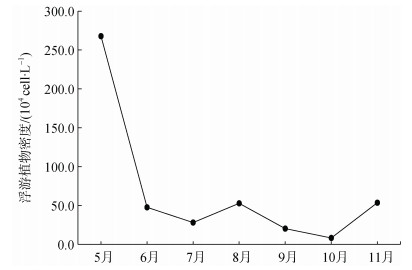 |
| 图 2 海湾扇贝养殖区浮游植物密度变化情况 Fig. 2 Changes in phytoplankton density in the bay scallop culture area |
浮游植物Shannon-Weaver生物多样性指数(图 3)范围0.458~3.747, 月平均2.694, 5月份生物多样性指数为0.458, 其他月份多样性指数均为2~3之间。根据Shannon-Wiener多样性指数评价等级[15], 该海域大部分时间处于中污染状态。
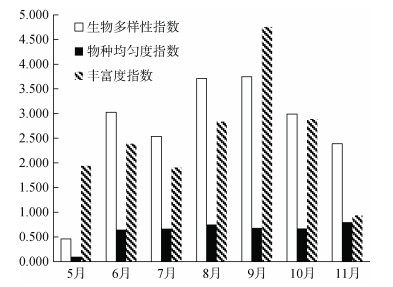 |
| 图 3 海湾扇贝养殖区浮游植物群落特征指数 Fig. 3 Phytoplankton community characteristic index in the bay scallop culture area |
Pielou物种均匀度指数范围(图 3)0.099~0.796, 均值为0.615。根据Pielou物种均匀度指数评价等级[16], 除5月份为重污染状态, 6—11月均处于清洁—寡污型状态。
Margalef物种丰富度指数范围(图 3)0.933~4.755, 均值为2.525, 9月份物种丰富度指数为4.755, 11月为0.933, 其余月份的物种丰富度处于1~3之间。按照Margalef物种丰富度指数评价等级[17], 该海域基本处于轻污染—中污染状态。
2.2 水质因子变化特征2020年海湾扇贝养殖区水质因子变化情况见图 4。海水水温变化范围11.8~26.8 ℃, 盐度变化范围为28.8~34.0, 均呈先升后降的趋势; pH变化范围为7.867~8.190, 化学需氧量为0.260~1.415 mg/L, 基本呈“下降—上升”趋势; 活性磷酸盐含量维持在0.003~0.006 mg/L之间, 5月、11月含量最高, 为0.006 mg/L, 10月份的活性磷酸盐含量最低, 为0.003 mg/L; 活性硅酸盐含量为0.025~0.627 mg/L之间, 7月份最高, 11月最低, 呈“上升—下降”趋势; 氮盐以硝酸盐氮为主, 硝酸盐氮含量为0.057~ 0.284 mg/L, 8月份含量最高, 11月含量最低, 呈“上升—下降”趋势, 亚硝酸盐氮及氨氮含量极低。
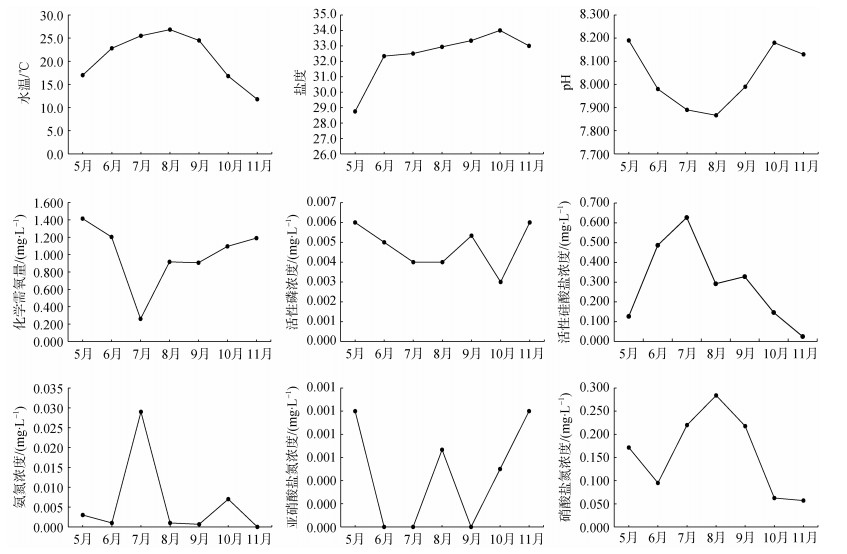 |
| 图 4 调查海域常规因子指标变化情况 Fig. 4 Changes in conventional factor indicators in the surveyed sea area |
参加排序的水质因子共解释了94.26% 的物种累积变化信息。分析结果(表 2)表明, 轴1和轴2解释了总体的99.79% 的物种变化信息, 特征值分别为0.810 5和0.130 0。常规水质因子检验结果显示(表 3), 活性硅酸盐、盐度、活性磷酸盐和硝酸盐氮的解释度分别为47.3%、20.1%、13.0%、13.8%, 说明这四种水质因子是影响该海域浮游植物优势种分布的关键环境因子, 但不能独立解释浮游植物群落的特征变化。
| 排序轴 | 1 | 2 | 3 | 4 |
| 特征值 | 0.810 5 | 0.130 0 | 0.001 8 | 0.000 3 |
| 解释变量(积累)/% | 81.05 | 94.05 | 94.23 | 94.26 |
| 相关性 | 0.991 0 | 0.968 7 | 0.224 4 | 0.462 0 |
| 物种—环境相关性累计变化率/% | 81.99 | 99.79 | 99.97 | 100.00 |
| 常规水质因子 | 解释度/% | F | P |
| 活性硅酸盐 | 47.3 | 4.5 | 0.058 |
| 盐度 | 20.1 | 2.5 | 0.118 |
| 活性磷酸盐 | 13.0 | 2.0 | 0.180 |
| 硝酸盐氮 | 13.8 | 4.8 | 0.088 |
通过Canoco 5.0软件对33种浮游植物优势种以门为单位与常规水质因子进行分析(图 5), 活性硅酸盐与活性磷酸盐呈负相关; 盐度与活性磷酸盐呈正相关, 与硝酸盐氮呈负相关; 活性磷酸盐与硝酸盐氮呈负相关。硅藻门、裸藻门与活性磷酸盐、盐度呈正相关, 与活性硅酸盐、硝酸盐氮呈负相关, 且硝酸盐氮、活性硅酸盐、盐度影响较大, 受活性磷酸盐影响较小; 甲藻门与活性硅酸盐呈正相关, 与活性磷酸盐、硝酸盐氮呈负相关, 受活性磷酸盐影响程度小; 隐藻门与活性硅酸盐、盐度成正相关, 与硝酸盐氮呈负相关。
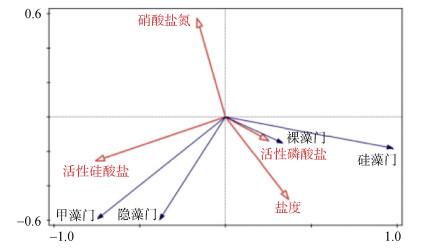 |
| 图 5 浮游植物优势种与常规水质因子的冗余分析(RDA)排序 Fig. 5 Redundancy analysis sequencing of dominant phytoplankton species and conventional water quality factors |
海湾扇贝养殖区水温变化呈季节性变化, 海水盐度与季节关系不明显, 除5月份低于30.0外, 6—11月盐度维持在32.3—34.0之间, 褐潮期间秦皇岛海域6—7月盐度变化为26.0—29.0且日间波动不定[18], 相比较而言, 监测期间该海域海水盐度稳定性较高。6—9月份, 该海域pH值偏低, 可能与降雨及浮游植物密度降低有关, 光合作用较弱导致海水CO2浓度升高, 降低海水的pH值[18]。各月份化学需氧量较低, 均符合国家一类水质标准(COD≤2 mg/L), 有利于海洋生物、浮游植物的生存。
调查海域的活性磷酸盐含量各月份基本无明显变化, 相差最大为0.003 mg/L。三氮营养盐浓度: 硝酸盐氮>氨氮>亚硝酸盐氮, 亚硝酸盐氮含量极低, 硝酸盐氮含量在6—8月上升, 氨氮含量在7月最高, 可能与在此期间海湾扇贝苗种移入海中有关[19]。活性硅酸盐浓度在7月份以后持续降低, 推断与海湾扇贝对硅藻类的滤食有关。根据Justic等[20]建立的营养盐化学计量限制标准: 若Si/P>22, N/P>22, 则受磷酸盐限制; 若N/P<10, Si/N>1, 则受无机氮限制; 若Si/P<10, Si/N<1, 则受硅酸盐限制。海水中营养元素低于阈值(CDIN=0.028 mg/L, CP=0.031 mg/L, CSi= 0.002 8 mg/L), 可判断该元素为限制因子[21]。根据以上原则判定, 调查海域5—11月均表现为磷酸盐限制, 11月也存在硅酸盐限制。
3.2 浮游植物变化规律调查海区共鉴定69种浮游植物, 其中硅藻48种, 甲藻14种, 浮游植物组成在各不同月份差异明显, 浮游植物结构与福建菲律宾蛤仔育苗垦区的调查结果相似[22], 说明该海区内浮游植物群落结构较为稳定。
常见浮游植物种群中, 硅藻门的角毛藻属、菱形藻属和甲藻门的原甲藻属、多甲藻属的种类较多。原甲藻属是扇贝、牡蛎和幼鱼等的饵料, 但其大量繁殖时会引发赤潮, 成为重要的赤潮种[23]。
物种多样性是群落组织独特的生物学特征, 其作用是表征浮游植物群落的结构类型、所处的发展阶段、生境质量差异[24], 与生物种类呈正相关。本调查中, 5月份浮游植物多样性指数偏低, 可能与骨条藻优势度过大有关, 另外, 优势种抢占了其他浮游植物种类生存空间, 导致均匀度降低[13]。秦皇岛海域为开放型海域, 调查海域站位由于距岸远、海水流动性较强、受到陆源排放物影响小等因素[25], 6—10月调查海域浮游植物群落指标普遍较高。
3.3 水质因子与优势种的关系调查海域的水质因子中, 活性硅酸盐、盐度、活性磷酸盐和硝酸盐氮是影响该海域浮游植物分布的关键环境因子。N、P和Si是海洋微藻类生存三大元素, 对浮游植物的群落有重要作用[26]。
硅藻门全年均为该海域浮游生物主体, 骨条藻的优势度在5月、6月较大, 有研究表明氮限制和高盐度会促进骨条藻细胞的生长及合成营养物质[27], 该海域内5—6月氮营养盐浓度低, 促进了骨条藻的成为主要优势种, 而活性硅酸盐6—7月浓度较高, 促使中肋骨条藻连续3月均成为优势种。其中, 成为优势种不仅由营养盐所影响, 还由于沿海风、水温等发挥重要作用[28]。硅藻门与活性磷酸盐、盐度呈正相关, 与活性硅酸盐、硝酸盐氮呈负相关。硅藻类浮游植物在种数、丰度均远高于其他藻类, 由于硅藻生长的完整周期中需要摄取大量的活性硅酸盐, 而调查海区内活性硅酸盐被硅藻吸收利用, 导致活性硅酸盐含量减少。石峰等[29]研究表明: 氮、磷、硅营养盐的减少则随浮游植物增加而被消耗, 硅酸盐被硅藻类浮游植物大量消耗, 并表现出补充量不足, 导致硅藻与硅酸盐呈负相关现象。硅藻在15~35 ℃之间均可较好地生长[30], 该海域中部分月份表现氮营养盐含量不高却被硅藻积极利用, 且水温达到26.8 ℃, 也为硅藻提供了生长环境进行大量繁殖。
| [1] |
方笑, 张福崇, 王六顺, 等. 海湾扇贝(Argopecten irradians)新品种"海益丰12"养殖效果评价[J]. 河北渔业, 2019, 6: 1-3. FANG Xiao, ZHANG Fuchong, WANG Liushun, et al. Evaluation of the breeding effect of a new species of bay scallop (Argopecten irradians) "Haiyifeng 12"[J]. Hebei Fisheries, 2019, 6: 1-3. |
| [2] |
GUO X, LUO Y. Scallops and scallop aquaculture in China, Developments in Aquaculture and Fisheries Science, 2016, 937-952. |
| [3] |
胡博, 谭丽菊, 王江涛. 昌黎近岸海域扇贝养殖区沉积物-水界面溶解无机氮磷及尿素扩散通量研究[J]. 海洋环境科学, 2017, 36(6): 864-870. HU Bo, TAN Liju, WANG Jiangtao. Study on the diffusion fluxes of dissolved inorganic nitrogen phosphorus and urea across sediment-water interface in scallop culture area of Changli coastal waters[J]. Marine Environmental Science, 2017, 36(6): 864-870. |
| [4] |
郑向荣, 张福崇, 吴新民, 等. 昌黎县海湾扇贝养殖区的营养盐[J]. 河北渔业, 2011, 1: 35-38. ZHENG Xiangrong, ZHANG Fuchong, WU Xinmin, et al. Nutrients in bay scallop culture area in Changli County[J]. Hebei Fisheries, 2011, 1: 35-38. |
| [5] |
晋利, 丁洁然. 褐潮对秦皇岛近海养殖业的危害及其防治对策[J]. 中国环境管理干部学院学报, 2016, 26(1): 84-85. JIN Li, DING Jieran. Impacts of brown tide on Qinhuangdao inshore marine aquaculture and prevention and cure countermeasures[J]. Journal of China Institute of Environmental Management, 2016, 26(1): 84-85. |
| [6] |
公晗. 秦皇岛海域"褐潮"对几种海洋生物影响的初步研究[D]. 北京: 中国科学院大学(海洋研究所), 2014. GONG Han. Preliminary study on the effects of "brown tide" in Qinhuangdao on marine organisms[D]. Beijing: University of the Chinese Academy of Sciences (Institute of Oceanology), 2014. |
| [7] |
张建乐, 张秋丰. 秦皇岛沿岸浮游植物与赤潮生物的初步研究[J]. 河北渔业, 2007, 7: 7-12. ZHANG Jianle, ZHANG Qiufeng. A preliminary study on phytoplankton and red tide organisms along the coast of Qinhuangdao[J]. Hebei Fisheries, 2007, 7: 7-12. |
| [8] |
慕建东, 郑向荣, 赵振良, 等. 秦皇岛海域赤潮期间浮游植物的生态特征[J]. 中国水产科学, 2015, 22(2): 288-301. MU Jiandong, ZHENG Xiangrong, ZHAO Zhenliang, et al. Ecological characteristics of phytoplankton in Qinhuangdao coastal areas during the red-tide period[J]. Journal of Fishery Sciences of China, 2015, 22(2): 288-301. |
| [9] |
赵广拓, 刘云鹏, 张秀文, 等. 昌黎县海湾扇贝养殖海域水质调查与评价[J]. 河北渔业, 2019, 2: 35-41. ZHAO Guangtuo, LIU Yunpeng, ZHANG Xiuwen, et al. Investigation and evaluation of the water quality of the scallop culture area in Changli County[J]. Hebei Fisheries, 2019, 2: 35-41. |
| [10] |
GB 17378.4—2007, 海洋监测规范 第4部分: 海水分析[S]. GB 17378.4—2007, The specification for marine monitoring—Part 4: Seawater analysis[S]. |
| [11] |
GB 17378.7—2007, 海洋监测规范 第7部分: 近海污染生态调查和生物监测[S]. GB 17378.7—2007, The specification for marine monitoring—Part 7: Ecological survey for offshore pollution and biological monitoring[S]. |
| [12] |
GB/T 12763.4—2007, 海洋调查规范 第4部分: 海水化学要素调查[S]. GB/T 12763.4—2007, Specifications for oceanographic survey—Part 4: Survey of chemical parameters in sea water[S]. |
| [13] |
籍辰旭, 陈逍遥, 陈火荣, 等. 三沙湾春季浮游植物群落结构特征[J]. 渔业研究, 2021, 43(1): 42-52. JI Chenxu, CHEN Xiaoyao, CHEN Huorong, et al. Characteristic of phytoplankton community structure in Sansha Bay of Fujian Province in spring[J]. Journal of Fisheries Research, 2021, 43(1): 42-52. |
| [14] |
杨娜, 段元亮, 包炎琳, 等. 杭州湾人工潟湖夏季浮游植物群落演替与环境因子的关系[J]. 上海海洋大学学报, 2020, 29(5): 757-769. YANG Na, DUAN Yuanliang, BAO Yanlin, et al. Relationship between summer phytoplankton community succession and environment factors in the artificial lagoon of Hangzhou bay[J]. Journal of Shanghai Ocean University, 2020, 29(5): 757-769. |
| [15] |
李钥, 李秋华, 陈文生, 等. 贵州三板溪水库后生浮游动物群落结构的动态变化[J]. 湖泊科学, 2016, 28(2): 340-349. LI Yao, LI Qiuhua, CHEN Wensheng, et al. Dynamic changes of metazooplankton community structure in Sanbanxi Reservoir, Guizhou Province[J]. Journal of Lake Sciences, 2016, 28(2): 340-349. |
| [16] |
吴天浩, 刘劲松, 邓建明, 等. 大型过水性湖泊——洪泽湖浮游植物群落结构及其水质生物评价[J]. 湖泊科学, 2019, 31(2): 440-448. WU Tianhao, LIU Jinsong, DENG Jianming, et al. Community structure of phytoplankton and bioassessment of water quality in a large water-carrying lake, Lake Hongze[J]. Journal of Lake Sciences, 2019, 31(2): 440-448. |
| [17] |
马方方, 张万磊, 张永丰, 等. 2013—2014年秦皇岛海域褐潮期间浮标主要水质参数变化[J]. 海洋环境科学, 2016, 35(4): 520-525. MA Fangfang, ZHANG Wanlei, ZHANG Yongfeng, et al. Data changes of main water quality parameters of monitoring buoys during brown tide blooms in Qinhuangdao between 2013 and 2014[J]. Marine Environmental Science, 2016, 35(4): 520-525. |
| [18] |
张艳军, 赵润德, 胡跃诚, 等. 强降雨对胶州湾生源要素补充和分布的影响[J]. 中国海洋大学学报(自然科学版), 2016, 46(4): 79-88. ZHANG Yanjun, ZHAO Runde, HU Yuecheng, et al. The influence of typhoon-induced precipitation on biogenic element supplementary and distribution of Jiaozhou Bay[J]. Periodical of Ocean University of China, 2016, 46(4): 79-88. |
| [19] |
于潇, 李希磊, 杨俊丽, 等. 烟台四十里湾扇贝养殖区水质评价及对浮游植物的影响[J]. 水产学杂志, 2020, 33(5): 58-64. YU Xiao, LI Xilei, YANG Junli, et al. Evaluation and effect of water quality on phytoplankton of scallop culture area in Sishili Bay in Yantai[J]. Chinese Journal of Fisheries, 2020, 33(5): 58-64. |
| [20] |
DUBRAVKO J, NANCY N. RABALAIS, R. Eugene Turner, et al. Changes in nutrient structure of river-dominated coastal waters: stoichiometric nutrient balance and its consequences[J]. Estuarine, Coastal and Shelf Science, 1995, 40(3): 339-356. |
| [21] |
陈丹丹, 庞巧珠, 涂志刚, 等. 后水湾深水网箱养殖区浮游植物群落季节变化及其与环境因子的关系[J]. 海洋环境科学, 2021, 40(1): 73-80. CHEN Dandan, PANG Qiaozhu, TU Zhigang, et al. Seasonal variation of phytoplankton community and its relationship with environmental factors in deep-water cage aquaculture area of Houshui bay[J]. Marine Environmental Science, 2021, 40(1): 73-80. |
| [22] |
祁剑飞, 郑雅友, 巫旗生, 等. 菲律宾蛤仔育苗垦区浮游植物群落结构及其与水质因子的关系[J]. 厦门大学学报(自然科学版), 2020, 59(1): 55-60. QI Jianfei, ZHENG Yayou, WU Qisheng, et al. Phytoplankton community structure and its relationship with water quality factors in the breeding pond of Ruditapes Philippinarum[J]. Journal of Xiamen University (Natural Science), 2020, 59(1): 55-60. |
| [23] |
陶邦一, 毛志华, 朱乾坤. 基于MODIS的东海原甲藻赤潮识别算法研究[A]. 浙江省减灾委员会办公室、浙江省科学技术协会. 第二届浙江减灾之路学术研讨会论文集[C]. 浙江省减灾委员会办公室、浙江省科学技术协会, 2016: 9. TAO Bangyi, MAO Zhihua, ZHU Qiankun. Research on Prorocentrum donghaiense red tide recognition algorithm based on MODIS[A]. Office of Zhejiang Disaster Reduction Committee, Zhejiang Science and Technology Association. Proceedings of the Second Zhejiang Disaster Reduction Road Symposium[C]. Office of Zhejiang Disaster Reduction Committee, Zhejiang Science and Technology Association, 2016: 9. |
| [24] |
冷春梅, 曹振杰, 张金路, 等. 黄河口浮游生物群落结构特征及环境质量评价[J]. 海洋环境科学, 2014, 33(3): 360-365. LENG Chunmei, CAO Zhenjie, ZHANG Jinlu, et al. Community characteristic of plankton and water quality assessment of the Yellow River Estuary[J]. Marine Environmental Science, 2014, 33(3): 360-365. |
| [25] |
陈丽梅, 刘利华, 贾晓平, 等. 2012年大神堂贝类养殖区浮游生物的群落结构[J]. 水生态学杂志, 2014, 35(1): 28-33. CHEN Limei, LIU Lihua, JIA Xiaoping, et al. Plankton community structure in shellfish culture area of Dashentang in 2012[J]. Journal of Hydroecology, 2014, 35(1): 28-33. |
| [26] |
武丹, 韩龙, 梅鹏蔚, 等. 渤海湾浮游植物群落特征及其环境影响因子[J]. 环境科学与技术, 2016, 39(4): 68-73. WU Dan, HAN Long, MEI Pengwei, et al. Phytoplankton community characteristics and environmental impact factors in the Bohai Bay[J]. Environmental Science & Technology, 2016, 39(4): 68-73. |
| [27] |
胡婧文, 弋钰昕, 尤庆敏, 等. 骨条藻属硅藻的分类、生态及生理研究进展[J]. 上海师范大学学报(自然科学版), 2020, 49(6): 698-7-8. HU Jingwen, YI Yuxin, YOU Qingmin, et al. Taxonomic, ecological and physiological research progress in Skeletonema (Bacillariophyta)[J]. Journal of Shanghai Normal University (Natural Science), 2020, 49(6): 698-7-8. |
| [28] |
LI Chunqiang, ZHU Baibi, CHEN Hong, et al. The relationship between the Skeletonema costatum red tide and environmental factors in Hongsha Bay of Sanya, South China Sea[J]. Journal of Coastal Research, 2009, 25(3): 651-658. |
| [29] |
石峰, 王修林, 石晓勇, 等. 东海沉积物—海水界面营养盐交换通量的初步研究[J]. 海洋环境科学, 2004, 23(1): 5-8. SHI Feng, WANG Xiulin, SHI Xiaoyong, et al. Benthic flux of dissolved nutrients at the sediment-water interface in the East China Sea[J]. Marine Environmental Science, 2004, 23(1): 5-8. |
| [30] |
王利利. 水动力条件下藻类生长相关影响因素研究[D]. 重庆: 重庆大学, 2006. WANG Lili. Research on the Relevant Factors of the Algal Growth in Hydrodynamic Condition[D]. Chongqing: Chongqing University, 2006. |
 2022, Vol. 46
2022, Vol. 46


